Various damage to electrical devices can occur in the wiring at any time. To reduce the risk of hazardous factors of electric shock, household protective devices are used that perform various functions.
A circuit breaker, a difavtomat and an RCD in the complex increase electrical safety, quickly turn off emerging accidents, and save people from. However, they have significant differences in operation and design.
To analyze them, first consider the types of possible malfunctions in the power grid that eliminate these devices. They can manifest themselves:
1.short circuit, which occurs when the electrical resistance of the load decreases to very small values due to the shunting of voltage circuits by metal objects; 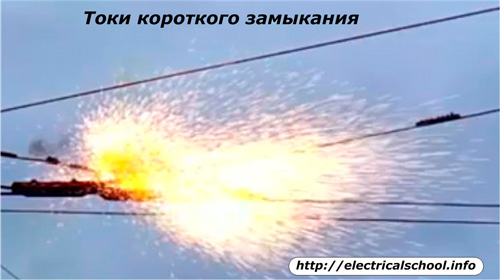
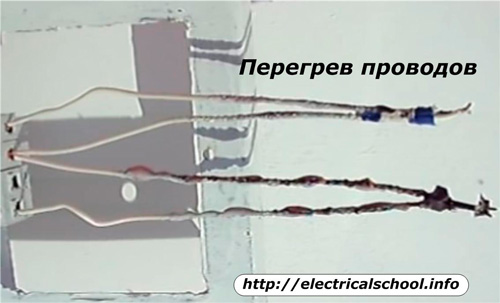
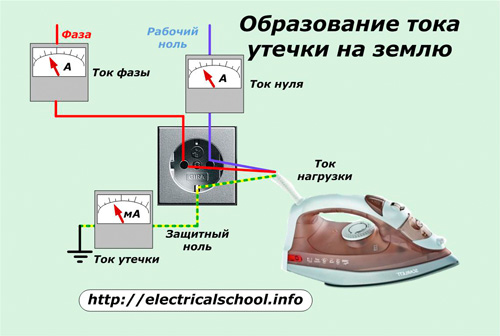
To worsen the situation with the appearance of malfunctions can:
old aluminum electrical wiring, laid decades ago using outdated technologies. It has long been used to the limit of its capabilities when powering modern electrical appliances;
poor-quality installation and the use of coarse protective devices even in a new electrical circuit.
To simplify the explanation of the differences between protective devices, we will consider only those devices that are intended for a single-phase network, because three-phase structures work in completely the same way according to the same laws.
Differences between protective devices by purpose
Circuit breaker
The industry produces many varieties of it. They are designed to eliminate the first two types of noted faults. To do this, their design includes:
a high-speed electromagnetic tripping coil that eliminates short-circuit currents and a system for extinguishing the resulting electric arc;
a time-delayed thermal release based on a bimetallic plate, eliminating overloads occurring within electrical circuits.
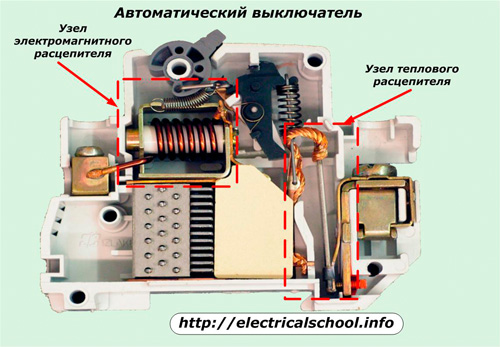
The circuit breaker for residential buildings is connected to one phase conductor and only monitors the currents passing through it. It does not react at all to the resulting leakage currents.
Residual current device
An RCD in a two-wire circuit is connected through two wires: phase and zero. It constantly compares the currents circulating in them and calculates their difference.
When the current leaving the neutral conductor corresponds in magnitude to that entering the phase wire, the RCD does not turn off the circuit, it allows it to work. In the event of small deviations in these values, which do not affect the safety of people, the residual current device also does not block the power supply.
The RCD removes the voltage from the wires suitable for it in the case when a leakage current of a dangerous magnitude occurs inside the controlled circuit, which can harm human health or operating electrical equipment. For this purpose, the residual current device is configured to trip when the current difference reaches a certain setting.
In this way, false alarms are excluded and opportunities are created for reliable operation of protection to eliminate leakage currents.
However, the very design of this device does not have any protection against the possible occurrence of short-circuit currents and even overloads in the controlled circuit. This explains the fact that the RCD itself must be protected from these factors.
The residual current device is always connected in series in a circuit with a circuit breaker.
Differential automaton
Its device is more complex than that of a circuit breaker or RCD. During operation, it eliminates all three types of faults (short circuit, overload, leakage) that can occur in the wiring. The difavtomat has in its design an electromagnetic and thermal release that protects the RCD built into it.
The differential automatic device is made in one module, has the functions of a circuit breaker and a residual current device combined.
Considering all of the above, we can conclude that it is necessary to further compare the characteristics of only two structures:
differential automaton;
block of protection from RCD with a circuit breaker.
This will be technically justified and correct.
Differences in protection in terms of performance
Dimensions (edit)
The modern modular design of devices with the possibility of mounting them on a din-rail significantly reduces the space required for their installation inside an apartment or floor panel. But, even this technique does not always exclude the lack of space for completing the wiring with new protective devices. RCDs with a circuit breaker are manufactured in self-contained housings and are mounted in two separate modules, and the difavtomat is only one.
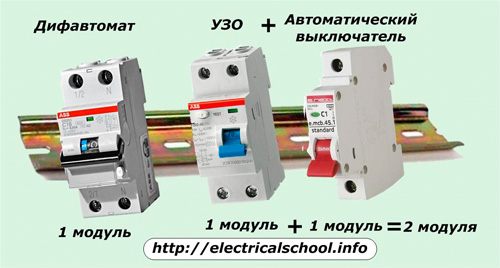
This is always taken into account when creating a project for electrical work in new houses and shields are chosen even with a small margin of internal space for future circuit improvements. But when reconstructing wiring or minor repairs of premises, they are not always engaged in replacing shields, and the lack of space in them can become a problem.
Tasks performed
At first glance, an RCD with a circuit breaker and a difavtomat solve the same issues. But let's try to concretize them.
Let's say a block of several sockets is installed in the kitchen to power various devices of unequal power: a dishwasher, a refrigerator, an electric kettle, a microwave oven ... They turn on randomly and create a load of random value. In certain situations, the power of several operating devices can exceed the rated value of the protections and create an overcurrent for them.
The installed difavtomat will have to be changed to a more powerful one. When using an RCD, it is sufficient to replace the cheaper circuit breaker.
When it is necessary to protect one electrical device connected by a separate, dedicated line, it is better to use a differential machine. It just needs to be selected according to the technical characteristics of a particular consumer.
Installation work
There are no big differences in fixing one or two modules to a din-rail. But when you connect the wires, the amount of work becomes greater.
If the difavtomat and the RCD cut into the phase and zero wires, then you will also need to lay jumpers to the circuit breaker to connect to the phase wire in series with the RCD. In certain cases, this can complicate the assembly of the circuit.
Quality and reliability
There is a certain opinion among some electricians-practitioners that the durability and performance of the protections depend not only on the factory assembly by their manufacturer, but also on the complexity of the design, the number of parts included in the design, adjustment and fine-tuning of their technologies.
Difautomat is more complicated, it requires more operations to set up the interaction of parts, and at this point it can play somewhat to the designs of the RCD of the same manufacturer.
However, to apply this technique to all manufactured devices, to put it mildly, is not entirely correct, although many electricians abuse this. This is a rather controversial statement and it is not always confirmed in practice.
Maintainability and replacement
Breakage can occur in any protective device. When it cannot be removed on site, a new device will need to be purchased.
Buying a difavtomat is more expensive. In the case of operating an RCD with a circuit breaker, one of the devices will remain intact and will not require replacement. And this is a significant cost savings.
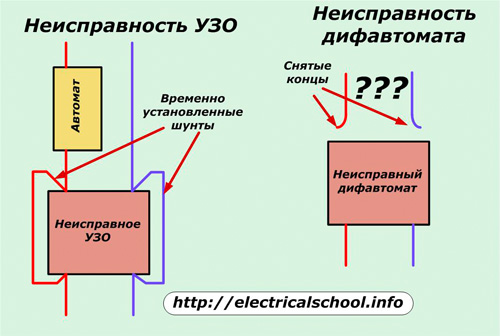
In the event of a breakdown of any protective device, the consumers powered through it are disconnected. In the event that the RCD is faulty, its circuits can be temporarily bypassed and power supplied through the circuit breaker. But, when the difavtomat is faulty, this will not work. It will need to be replaced with a new one or the circuit breaker delivered for a while.
Working conditions in different situations
The circuit for monitoring leakage currents for an RCD and a differential machine can be performed on a different element base using:
an electromechanical relay design that does not require an additional power source for the logic to work;
electronic or microprocessor technologies that require a power supply and a stabilized voltage from it.
They work in the same way in the normal state of suitable voltage circuits. But, if a malfunction occurs in the circuit, for example, to cut off the contact of one of the wires, say, zero, as they will be immediately visible. They work better and more reliably in the outdated two-wire circuit.
Determination of the reason for the trip by the protection
After the RCD is triggered, it is immediately clear that leakage currents have arisen in the circuit and it is necessary to check the insulation resistance of the protected area.
When the circuit breaker has worked, the reason lies in an overload of the circuit or a short circuit that has arisen.
But after turning off the differential machine of most models, it will take longer to look for the reason for removing the voltage and deal with both the insulation resistance of the wiring and the loads created inside the circuit. It is impossible to establish the cause immediately.
However, now it is possible to use expensive designs of difavtomats with signaling indicators about the activation of a certain type of protection.
Differences in markings on the case
Despite the same appearance of the RCD and the difavtomat (identical body, "Test" button, manual switch lever, similar terminal blocks for installing wires), it is enough to simply deal with them according to the diagrams and inscriptions made on their front side.
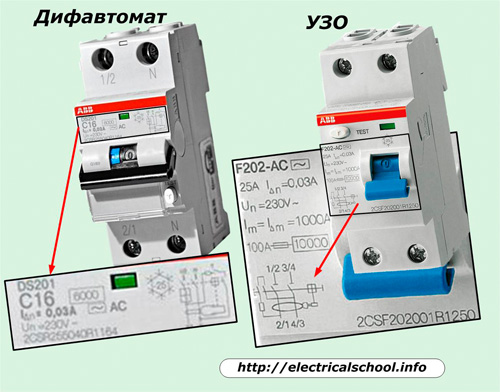
Devices of domestic manufacturers are marked so that the buyer can easily navigate the chosen models. Directly on the buildings you can see the inscription "Difavtomat" in a conspicuous place. The "RCD" marking is found on the rear wall.
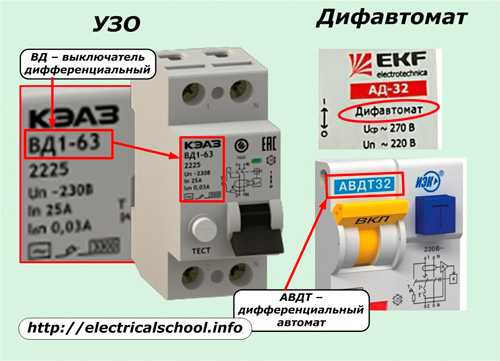
The designation "VD" on the plate informs that in front of us differential switch(correct technical name), which reacts exclusively to leakage currents and does not protect against overcurrent and short-circuit. They are labeled with an RCD.
The inscription "AVDT" (residual current circuit breaker) starts with the letter "A" and emphasizes the presence of circuit breaker functions. In this way, the diphatomat is denoted in the technical documentation.

